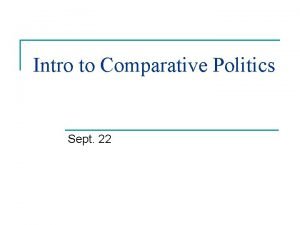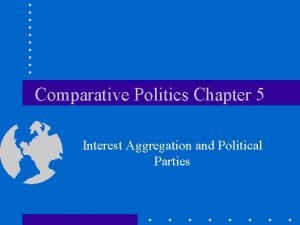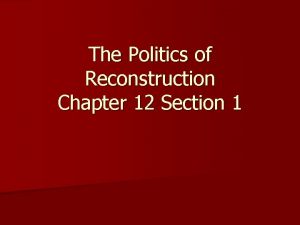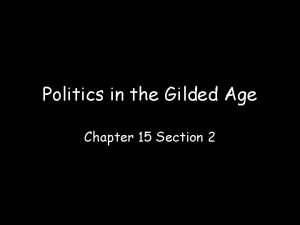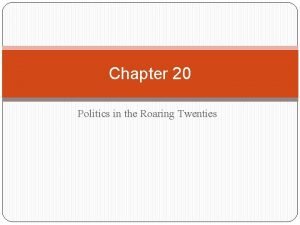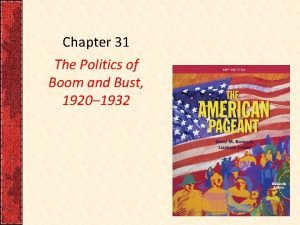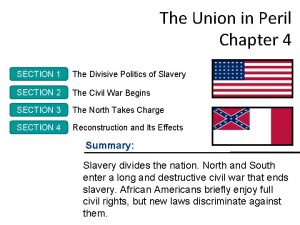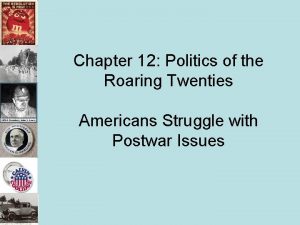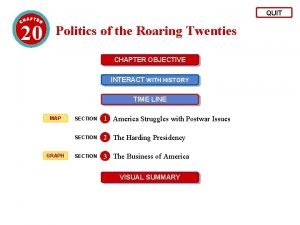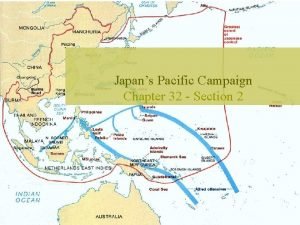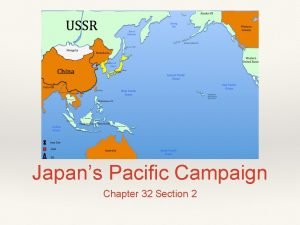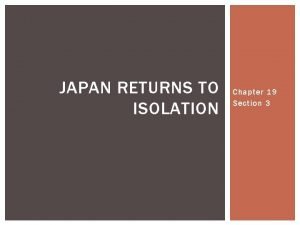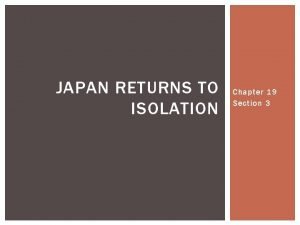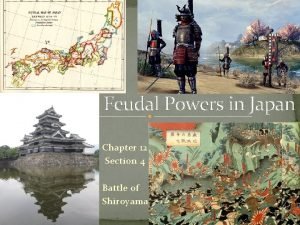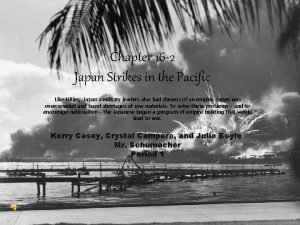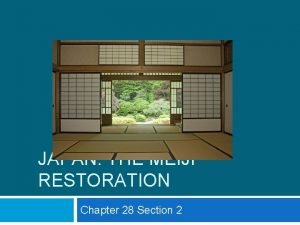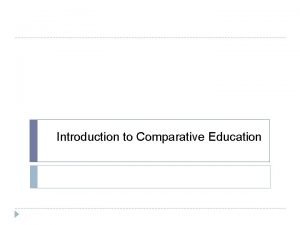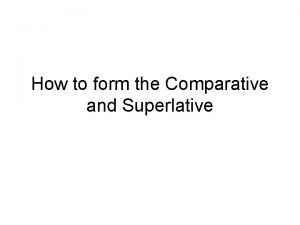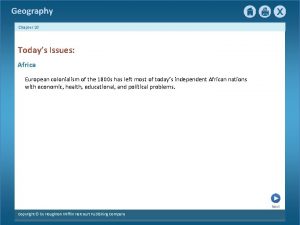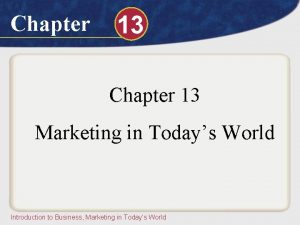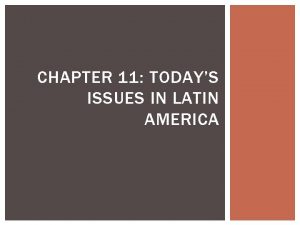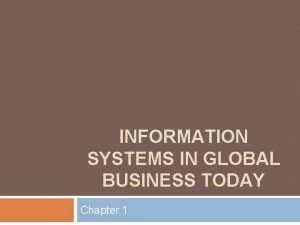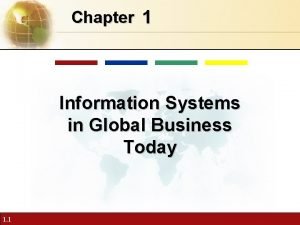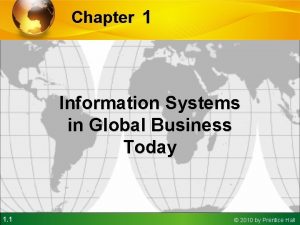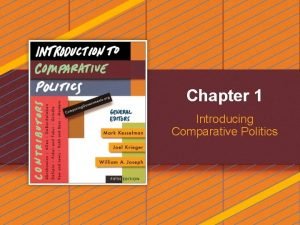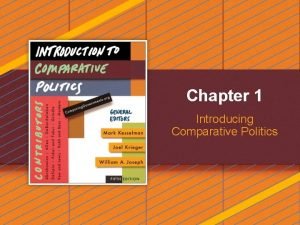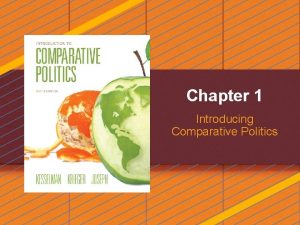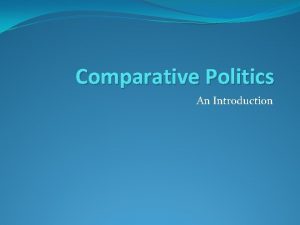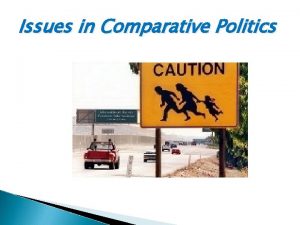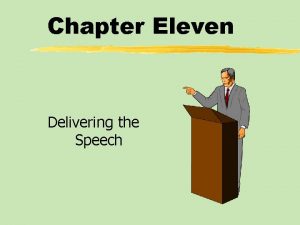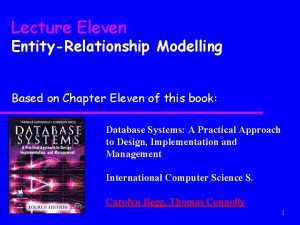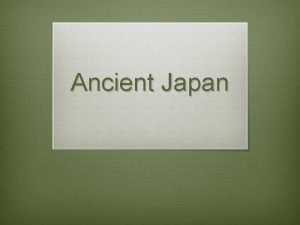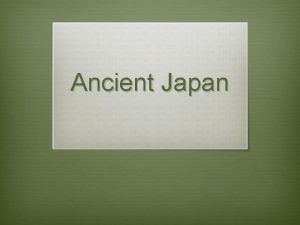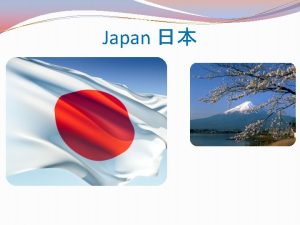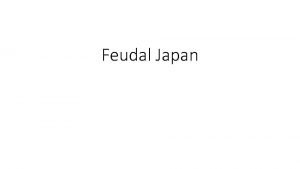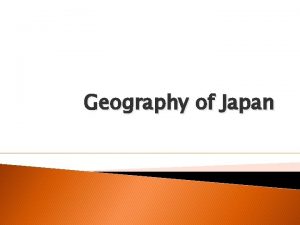Chapter Eleven Politics in Japan Comparative Politics Today












































- Slides: 44

Chapter Eleven Politics in Japan Comparative Politics Today, 9/e Almond, Powell, Dalton & Strøm Pearson Education, Inc. publishing as Longman © 2008


Country Bio: Japan § Population: § Territory: § Year of Independence: § Year of Current Constitution: § 127. 7 million § 145, 882 sq. miles § 660 B. C. § 1947 § Head of State: § Head of Government: § Emperor Akihito § Prime Minister Shinzo Abe § Language: § Japanese § Religion(s): § Observe both Shinto and Buddhist 84%%, other 16% (including Christian 0. 7%)

Background § Japan is the only long-lived democracy in East Asia. § Rapid economic growth post WWII § Fascinating to the world given Japan’s scarcity of natural resources and its overcrowded population. § 7 th most populous country in the world. § Only 20% of country is made up arable land. § How did it evolve into the 2 nd largest economy in the world? § Other countries want to figure out the “Japan model” of rapid development where government is seen as playing an important economic role. § Prolonged recession in the 1990 s § But still 2 nd largest economy

Background § Democracy but with atypical institutions § Constitution imposed on Japan by the U. S. -led occupation authorities in 1946. § Never amended that constitution. § Foreign origin and alien ideals § Undermined by actual political practices § Corruption § Powerful bureaucrats § Political stability has vanished temporarily § Party system has fragmented

Current Policy Challenges § Recession § 1997 Japan’s first full year of negative economic growth since 1975 § Banking crisis from the bursting of the inflated land price bubble of the late 1980 s § Mountains of unrecoverable loans § Deflation, unemployment and bankruptcies § Shocked the national psyche § Government slow to respond § Rapidly aging population § Closed domestic markets § Deregulation of economy needed

Current Policy Challenges § Need modernization of immigration policy § Security issues § Despite all these challenges Japanese remain among the wealthiest and longest-lived people in the world

Historical Origins of the Modern Japanese State § First inhabitants § Hunter-gatherers from the Asian mainland § Jomon - 11, 000 B. C. § 300 B. C. shift from Jomon culture occurred § New culture: Yayoi § § Use of bronze and iron, including weaponry Development of wet field rice agriculture Spread over islands Yamato, most powerful clan

Historical Origins of the Modern Japanese State § Japanese court sponsored Buddhism § Began to write histories, legal codes § Samurai’s began to assume more power and warred with each other § Tokugawa clan: ruled from 1600 to 1868 § Feudal system § Confucian doctrine

Historical Origins of the Modern Japanese State § Isolation § Commodore Matthew C. Perry § Open ports to trade § Meiji Restoration (1868) § Oligarchs § Constitution § Established the Diet § Nascent political parties § Taisho Democracy (1918 -1932) § § Cabinets dominated by political parties Zaibatsu favoritism Growth of military Ultranationalism

The Occupation § Allied Occupation of Japan § Administered by the Supreme Commander for the Allied Powers (SCAP) § U. S. General Douglas Mac. Arthur § Demilitarize and democratize Japan § Render Japan unable and unwilling to wage war ever again § New constitution § Peace Clause, Article 9 § Land reform § Independent trade-union movement § Structural changes to the bureaucracy

The Occupation § Goals shifted from demilitarization to securing Japan as a reliable ally in the Cold War § 1951 general peace treaty in San Francisco with allied powers except the Soviet Union § U. S. -Japan Mutual Security Treaty

Political Institutions § Japan’s system of government § Parliamentary, bicameral, and nonfederal § The National Diet: House of Representatives § House of Councillors § Local government § 47 Prefectures § Each elects its own governor and legislature § All local government authority is delegated and may be retracted § The Judiciary § Judicial independence; guaranteed in the Constitution § Cabinet directly appoints the 15 members of the Supreme Court § § Helps to appoint all lower court appointments as well LDP - only elderly judges; forced retirement Secretariat Malapportionment case


Electoral Systems and Electoral Competition § Two chambers of the National Diet use different electoral rules § Old electoral rules –House of Representatives § Return to Single Non-Transferable Vote (SNTV) system § LDP allowed candidates to create decentralized campaign organizations § Barriers to challengers § Lowered the electoral salience of issues § Restrictive rules for campaigning


Electoral Systems and Electoral Competition § New electoral rules- House of Representatives § Size of the House of Representatives set at 500, later reduced to 480 § 4 year terms § 300 elected on the basis of equal-sized single-member districts § 180 are elected from 11 regional districts by proportional representation § Each voter casts two votes: one for a candidate in the SMD and one for a party in the PR district § Zombies § Goal of new rules: eliminate intraparty competition

Electoral Systems and Electoral Competition § Electoral Rules – House of Councillors § Fixed six year terms § Half elected every three years § Each voter has two votes: § One cast in the prefectural SNTV district for an individual candidate § Second cast for a party in the national district (with each party receiving a share of the 50 PR seats that matches the share of the vote it receives) § Not much intraparty competition § Focus is on parties, not individuals § More issue-based campaigning

The Japanese Party System § Japanese party system combined multipartisim with the sustained dominance of one majority party. § The LDP § The Party System, 1946 -1955 § § § Somewhat chaotic Socialist Party - force in the Diet Japan Communist Party Japan Socialist Party Liberal Democratic Party § The Party System, 1955 -1993 § The 1960 s § The 1970 s § The 1980 s


The Japanese Party System: Since 1993 § Stability disappeared for a while § LDP tried to put together coalition party § Coalition was established § Contained seven parties except the LDP and the Communists § Goal: to complete the reform of the electoral system that the LDP had failed to accomplish


The Japanese Party System: Since 1993 § Electoral reform passed § Next on the agenda: tax reform § Conflict and the coalitional government collapsed § Who emerged? The LDP with the help of their once enemy, the Japan Socialist Party and a smaller party. § Produced the first Socialist prime minister § New party system has elements of single member district systems plus proportional systems § Effect: party consolidation, campaigns have changed, intraparty organization, advent of coalition government


Political Participation and Voting Behavior § By international standards, ordinary Japanese are not very politically involved. § Identify with political party through personal identification with candidate or through an interest group affiliated with the party. § Koenkai § Changing nature in modern Japan given the end of intraparty competition § Transformed themselves into district level party organizations § Voter turnout declining steadily on a nationwide basis § Recently party identification has declined as well § More independents

Interest Groups § Big Business § keiretsu § Small-and medium-sized businesses § Agriculture § Organized labor § Enterprise unions

Political Culture and Issue Cleavages § Hierarchy, homogeneity, and conformity to group objectives § Key concepts in the discussion of Japanese political culture § The feudal experience: hierarchy § Meiji attempt to Westernize culture may have produced backlash of nationalism found in pre-War and wartime Japan § Social hierarchy: family, workplace and in politics

Political Culture and Issue Cleavages § Women: At home and in the workplace § “good wives and wise mothers” § Equal Employment Opportunity Law § Glass ceiling low and impenetrable § Little help from government; little social welfare § Japanese women marry later and bear fewer children § Impact of aging society


Political Culture and Issue Cleavages § Ethnic homogeneity vs. immigration § Japan is not completely homogenous § A few minority groups § High discrimination § Koreans- brought to Japan during the war as laborers § Still treated poorly today; a few become naturalized citizens § Citizenship does not come with birth § Demands of Japanese citizenship and impact if one chooses not to § Ainu § Burakumin § Few strong issue cleavages § New immigrants § Need for young workers § Conformity § Theory of Japaneseness


Political Socialization § The family § Urban society with nuclear families § Role of women § Education § High achieving in math and science § “cram schools” § Good basic skills; university system in sad shape § Extremely difficult entrance exams, but little challenging coursework § Entry into workforce after four years unspoiled by liberal ideas § School refusal syndrome § Portrayal of war against China

Political Socialization § Mass media § Play a highly visible role in public life § Television media § “press club” § Transforming political culture § Role of issues/policy in politics § Koizumi



The Policymaking Process § Japan: parliamentary democracy with both houses of the Diet directly elected; with a prime minister and a cabinet chosen by the Lower House. § Tends to leave proposal of laws to the Cabinet and the Diet reserves the right to accept or reject or amend the proposals. § Cabinet delegates to bureaucracy the drafting of legislation

The Policymaking Process: How a Bill Becomes a Law § Members of either house may submit legislation § Member bills are almost always exercises in grandstanding

The Policymaking Process: How a Bill Becomes a Law- Typical Path § Ministry drafts legislation and submits it to Cabinet; Cabinet acts on it (accept, reject, or amend). If it is to go on, the Cabinet will send it to the Diet may do whatever it wishes to the bill. § Normal legislation must be passed identically in both houses unless the Lower House can override(2/3’s vote) an Upper House objection. § Never happened

The Policymaking Process: How a Bill Becomes a Law- Typical Path § If the bill is the annual budget, a treaty needing ratification, then only the Lower House need pass it. Upper House may delay it but not hold it up indefinitely. § Any bill passed by the Diet becomes the law of the land. § Final steps involve implementation: the bureaucracy § Elections allow the public to respond the performance of the government in power.

The Policymaking Process: The Bureaucracy § Very competent bureaucracy § Best and the brightest § Long hours; little pay § Prestige suffered in the 1990 s § Heavily involved in the policy-making process but not dominant given the parliamentary system § Why do they do it? § Devotion to public service; prestige; potential for early retirement and a second more lucrative career § Amakudari § Compensation loaded on the back end § Bureaucrat bashing

The Policymaking Process § The Diet: Rubber Stamp or Sovereign? § Weak and ineffective? § Majority party, LDP, intraparty conflict resolved § No need for conflict within Diet; not necessarily weak

Policy Performance § Industrial policy and the economic miracle § Trade policy § Security and foreign policy § Environmental pollution policy § Welfare policy: health care and pensions § Policy implications of political reform


Concluding Thoughts About Japanese Politics § The most important lesson is that the Japanese policy process has been, and continues to be, supremely political – even if, on the surface, it seems that an insulated army of smart bureaucrats is calling the shots.
 Today meeting or today's meeting
Today meeting or today's meeting Today class or today's class
Today class or today's class Today meeting or today's meeting
Today meeting or today's meeting Fingerprint ridge characteristics worksheet
Fingerprint ridge characteristics worksheet Today's lesson or today lesson
Today's lesson or today lesson Example of repitition
Example of repitition Comparative theories politics a level
Comparative theories politics a level Andrew heywood global politics latest edition
Andrew heywood global politics latest edition Approaches to the study of comparative politics
Approaches to the study of comparative politics Interest aggregation in comparative politics
Interest aggregation in comparative politics The politics of reconstruction chapter 12 section 1
The politics of reconstruction chapter 12 section 1 Pendleton civil service act
Pendleton civil service act Chapter 20 politics of the roaring twenties answer key
Chapter 20 politics of the roaring twenties answer key Lesson 5 african american culture and politics
Lesson 5 african american culture and politics Chapter 31 the politics of boom and bust
Chapter 31 the politics of boom and bust Reconstruction and its effects
Reconstruction and its effects Chapter 4 section 1 the divisive politics of slavery
Chapter 4 section 1 the divisive politics of slavery Chapter 15 section 3 politics in the gilded age
Chapter 15 section 3 politics in the gilded age Politics of the roaring twenties chapter 12
Politics of the roaring twenties chapter 12 Politics of the roaring twenties
Politics of the roaring twenties Chapter 20 politics of the roaring twenties
Chapter 20 politics of the roaring twenties Japan's pacific campaign chapter 32 section 2
Japan's pacific campaign chapter 32 section 2 Japan's pacific campaign chapter 32 section 2
Japan's pacific campaign chapter 32 section 2 Chapter 19 section 3 japan returns to isolation answer key
Chapter 19 section 3 japan returns to isolation answer key Chapter 19 section 3 japan returns to isolation
Chapter 19 section 3 japan returns to isolation Chapter 12 section 4 feudal powers in japan
Chapter 12 section 4 feudal powers in japan Chapter 16 section 2 japan strikes in the pacific
Chapter 16 section 2 japan strikes in the pacific Chapter 28 section 2 modernization in japan
Chapter 28 section 2 modernization in japan What is comparative education
What is comparative education Superlative form tall
Superlative form tall Comparative correlational research design
Comparative correlational research design Chapter 20 today's issues in africa
Chapter 20 today's issues in africa Chapter 20 today's issues in africa
Chapter 20 today's issues in africa Chapter 13 marketing in todays world
Chapter 13 marketing in todays world Chapter 13 marketing in today's world
Chapter 13 marketing in today's world Chapter 13 marketing in today's world
Chapter 13 marketing in today's world Chapter 11 today's issues in latin america
Chapter 11 today's issues in latin america Human flourishing nursing examples
Human flourishing nursing examples Business communication today 14th edition
Business communication today 14th edition To make place decisions marketers select the right
To make place decisions marketers select the right Global business today chapter 1
Global business today chapter 1 Family trends today
Family trends today Information systems in global business today
Information systems in global business today Information system in global business
Information system in global business Marketing today and tomorrow chapter 1
Marketing today and tomorrow chapter 1








